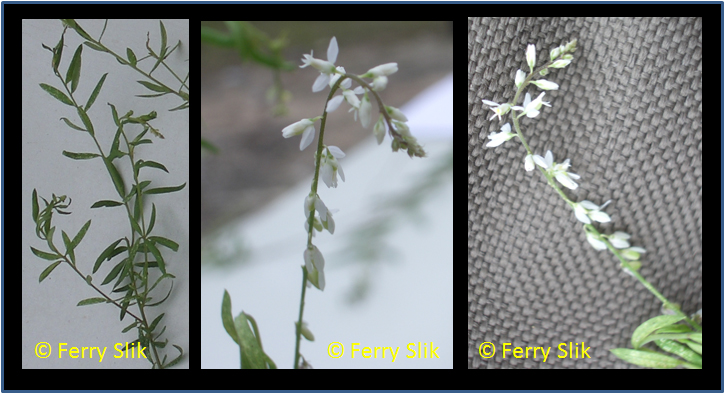Polygala paniculata L., Syst. Nat. ed. 10 2: 1154 (1759)
Name meaning 'branching infloresence'.Synonyms
Polygala paniculata var. leocoptera S.F. Blake
Description
Herbs annual, erect, 10-50 cm tall. Stems terete, mostly much branched, glandular pubescent. Leaves alternate, subsessile, lowest 4 or 5 often
in pseudowhorls; leaf blade lanceolate to linear-lanceolate, 5-20 x 1-4 mm, 1-veined, lateral veins absent, base attenuate, margin entire, apex
acute. Racemes terminal or opposite to leaves, 2-15 cm. Pedicel 0.5-1 mm; basal bracteoles caducous, lanceolate, apex acute. Sepals 5; outer
sepals 3, ~ elliptic, apex obtuse; inner sepals 2, purple, petaloid, elliptic-oblong, ca. 2 mm, 3-veined. Petals 3, white or violet; lateral
petals narrowly ovate-lanceolate, attenuate to apex; keel apex with multifid appendages. Stamens 8, forming an open staminal sheath glabrous
inside and split at top into 8 very short free filaments. Ovary obovoid to nearly globose; style straight, 1.5-2 x as long as ovary, apex
expanded into an oblique broad cup, upper portion of which ends in tuft of hair; stigma at base of cup. Capsule oblong, ca. 2 mm, not winged,
apex notched, glabrous. Seeds black, oblong, densely white pubescent; strophiole small, with 2 membranous appendages.
Ecology
Occurs in waste places, plantations and fields, on different soils, avoiding dry areas, often abundant, from sea-level up to 2250 m altitude.
Uses
A sweetened infusion of the aerial parts is a remedy for gonorrhoea and lumbago, and the pulverized leaves may be applied to wounds.
Distribution
A native of tropical America, but it naturalises easily in disturbed areas such as roadsides, forest edges and wasteland and is now widespread
throughout tropical Asia and the Pacific.
Local names
China: yuan zhui hua yuan zhi.
Indonesia: Jukut Rindik, Sasapuan, Katumpang Lemah.
